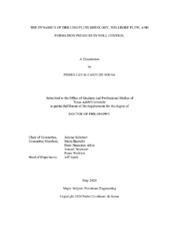| dc.description.abstract | Drillers dedicate many hours to well control training, where they learn how to identify a kick by looking at drilling parameters and comparing them to the planned values. In HPHT wells, UBD and other advanced drilling techniques, however, standard well-control operations and assumptions may lead to inaccurate influx size estimates and inappropriate handling of the kick. A limited number of studies on the rheological properties of drilling fluids in HPHT conditions is available. Initial works modeled density and viscosity of muds based on empiric-mechanistical models, but were limited to 350 °F and 20,000 psig. A large number of models are used to describe mud rheological behavior in HPHT, with no model being universally accepted. By modifying and upgrading a HPHT viscometer, we thoroughly analyze how well different models represent the experimental data in a wide range of pressure and temperature. Upward, gas-liquid flow studies are generally focused on describing flow in pipes. The same happens with larger diameter pipes where slug flow has been reported not to take place. In that slugless domain, only a handful of works takes in consideration the flow in annuli. Thus, we designed a flow loop circulating oil and air to explore the virtually untapped slugless regime in concentric and eccentric annuli. Additionally, estimating the intensity of a kick generally implies a tradeoff between computationally expensive and inaccurate (or improperly-used) methods. Here, we developed a computationally inexpensive tool capable of coupling the response of the producing formation to the changes in bottom-hole pressure due to the dynamics of wellbore flow. Our drilling fluid characterization and test methodology of uncontaminated and gas-cut muds helps delivering an accurate description of the frictional pressure losses during circulation of formation-fluid influxes. With the flow loop, we are able to give a better description of upward, gas-liquid flow behavior in slugless annuli, which is crucial in understanding the dynamics of wellbore during well control. Furthermore, the coupled wellbore-formation tool developed here accurately describes fluid influxes, being especially useful for managed pressure and underbalanced drilling. This works serves as the basis for more advanced well-control procedures, training, and understanding. | en |


